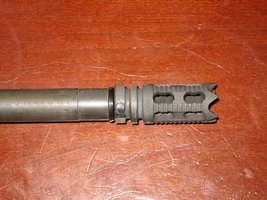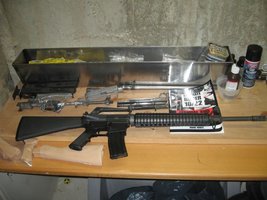I have an AR-15 that I've built up with a pre-ban A1 Colt 20" HBAR upper on a DPMS lower. Because the AWB never sunset here in MA, I needed to remove two of the "evil" features of the upper - namely the bayonet lug and the A2 flash suppressor that came with the upper. I took care of the bayonet lug with a cut-off wheel, a file, and a quick dab of cold blue. I now have a Yankee Hill Machine phantom muzzle brake / compensator, and I need to decide upon a method for permanently affixing it to the muzzle. As I understand it, the BATF-acceptable methods for permanent attachment are:
I have a MAP torch that I use to light my charcoal grill, and some silver solder left over from my model-airplane-landing-gear-fabrication days, and I also have a drill press and TIG and MIG welders. I don't have a vertical mill or a gun vice or an AR-15 upper receiver vice block. So I'm trying to figure out the best way to proceed.
Is one method preferable to the others in terms of ease of removal of the offending permanent attachment, in the event that I (hopefully) move to a free state some day?
If I go the silver solder method, do I need to sand the finish off the threads or use some sort of flux to get a good solder joint? Is a MAP torch going to do the trick?
If I weld, I'd probably MIG it, because I need practice to get used to the thickness of the part to be welded before I can make an acceptable TIG weld, and, obviously, I only get one shot at this. Any particular advice regarding metal prep?
If I drill and pin the brake to the barrel, do I need some sort of special bit to drill at tangent angle to the barrel, or can I just use a good quality bit and go slow? Do I need to go out and buy an upper receiver vice block, or can I just use some wood or rubber or aluminum in the vice jaws without damaging the barrel?
What about damage to the finish? Either silver solder or a weld will get it pretty hot - does the finish get screwed up and if so, can I just sand it down and hit it with some cold blue?
My apologies for the newbish questions but I really want to get this thing legal and registered here so I can shoot it at an Appleseed shoot in April. Besides, I'm going to have to do a similar neutering to a Yugo M90 underfolder and to a Hungarian AMMS that I'm building.
And for God's sake, please don't tell me to take it to a gunsmith or to ZHA or anything - that's why we have a buil-it-yourself forum.
- to use silver solder at the circumference of the threaded joint,
- welding either a bead along half the circumference or four equidistant circumferential tack welds, and
- blind pin method (pin with a tack weld or silver solder to seal either end of the pin).
I have a MAP torch that I use to light my charcoal grill, and some silver solder left over from my model-airplane-landing-gear-fabrication days, and I also have a drill press and TIG and MIG welders. I don't have a vertical mill or a gun vice or an AR-15 upper receiver vice block. So I'm trying to figure out the best way to proceed.
Is one method preferable to the others in terms of ease of removal of the offending permanent attachment, in the event that I (hopefully) move to a free state some day?
If I go the silver solder method, do I need to sand the finish off the threads or use some sort of flux to get a good solder joint? Is a MAP torch going to do the trick?
If I weld, I'd probably MIG it, because I need practice to get used to the thickness of the part to be welded before I can make an acceptable TIG weld, and, obviously, I only get one shot at this. Any particular advice regarding metal prep?
If I drill and pin the brake to the barrel, do I need some sort of special bit to drill at tangent angle to the barrel, or can I just use a good quality bit and go slow? Do I need to go out and buy an upper receiver vice block, or can I just use some wood or rubber or aluminum in the vice jaws without damaging the barrel?
What about damage to the finish? Either silver solder or a weld will get it pretty hot - does the finish get screwed up and if so, can I just sand it down and hit it with some cold blue?
My apologies for the newbish questions but I really want to get this thing legal and registered here so I can shoot it at an Appleseed shoot in April. Besides, I'm going to have to do a similar neutering to a Yugo M90 underfolder and to a Hungarian AMMS that I'm building.
And for God's sake, please don't tell me to take it to a gunsmith or to ZHA or anything - that's why we have a buil-it-yourself forum.


![Grin [grin] [grin]](/xen/styles/default/xenforo/smilies.vb/041.gif)
![Wink [wink] [wink]](/xen/styles/default/xenforo/smilies.vb/002.gif)

